Physical Address
304 North Cardinal St.
Dorchester Center, MA 02124
In surgical endocrine disease, thyroid disorders are common, adrenal disease is uncommon and parathyroid disease is rare.
The thyroid gland develops from the thyroglossal duct, which grows downwards from the pharynx through the developing hyoid bone. On the front of the trachea, the duct bifurcates and fuses with elements from the fourth branchial arch, from which the parafollicular (C) cells are derived.
The duct is normally obliterated in early foetal life but can persist in part to produce a thyroglossal cyst. The upper end of the duct is identified in adults as the foramen caecum at the junction of the anterior two-thirds and the posterior third of the tongue. Arrest of descent of the duct may result in an ectopic thyroid (e.g., lingual thyroid).
There are two pairs of parathyroid glands. The upper glands arise from the fourth branchial arch and are usually found at the back of the thyroid above the inferior thyroid artery. The lower glands arise from the third arch (in association with the thymus) and are less constant in position. They are usually found posterior to the lower pole of the thyroid lobes but can lie within the gland, some distance below it, in the upper mediastinum or within the thymus.
The lobes of the thyroid lie on the front and sides of the trachea and larynx at the level of the 5th to 7th cervical vertebrae ( Fig. 21.1 ). They are connected by a narrow isthmus, which overlies the second and third tracheal rings. The thyroid normally weighs 15 to 30 g and is invested by the pretracheal fascia that binds it to the larynx (oblique line of thyroid cartilage), cricoid cartilage (Berry ligament) and trachea ( Fig. 21.2 ). The strap muscles (sternohyoid and sternothyroid) lie in front of the pretracheal fascia and must be separated to gain access to the gland. It is difficult to feel the normal thyroid gland except at puberty and during pregnancy when physiologic enlargement occurs.
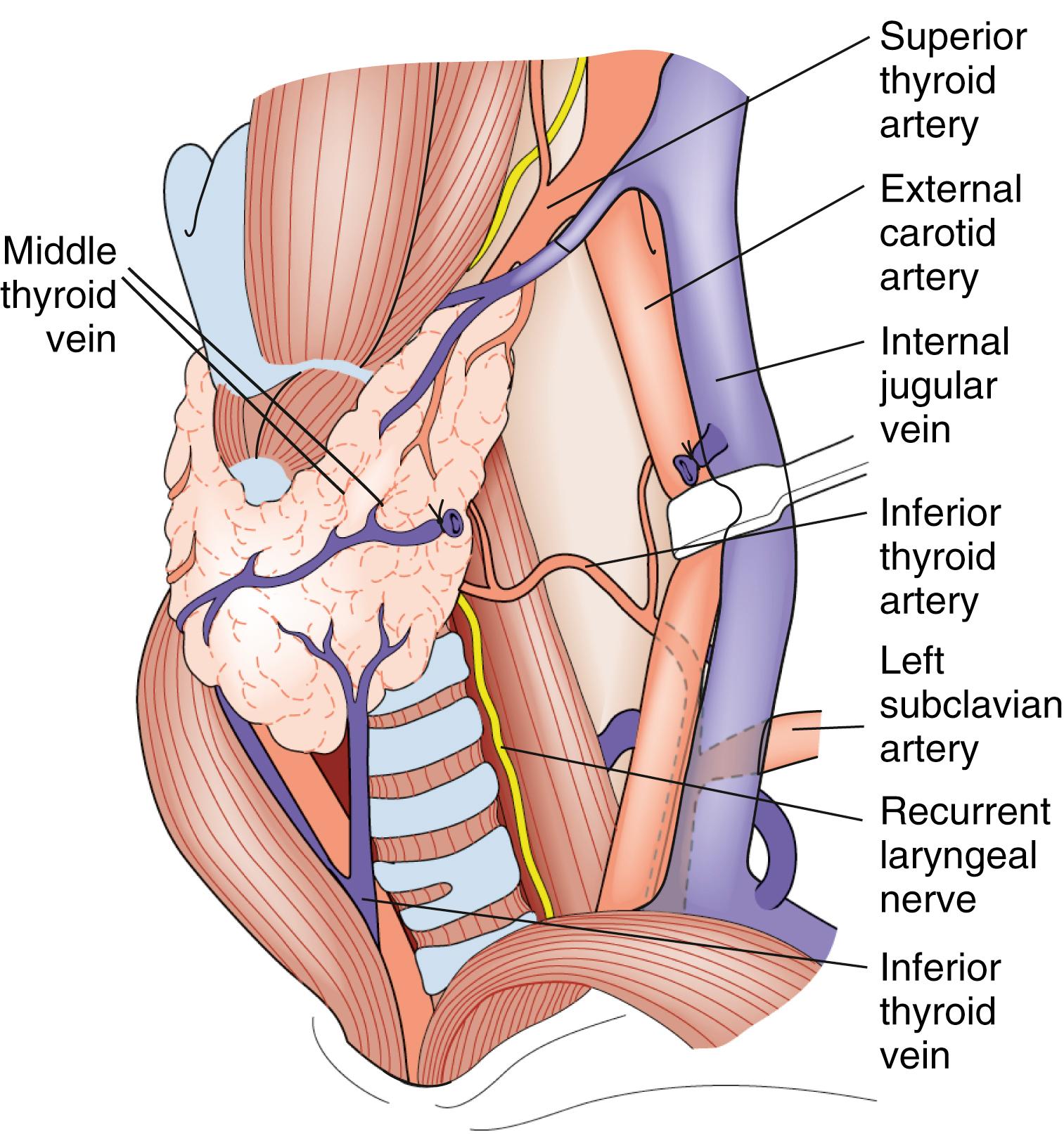

The superior thyroid artery runs down to the upper pole of the gland as a branch of the external carotid artery, whereas the inferior thyroid artery runs across to the lower pole from the thyrocervical trunk (a branch of the subclavian artery). As it nears the gland, the inferior thyroid artery divides into superior and inferior branches. The bifurcation is usually in front of the recurrent laryngeal nerve but may also be around it. Blood drains through superior, middle and inferior thyroid veins into the internal jugular and innominate veins. Lymphatics pass laterally to the deep cervical chain and downwards to pretracheal and mediastinal nodes.
Two branches of the vagus nerve are closely associated with the thyroid gland ( Table 21.1 ). The recurrent laryngeal nerve passes upwards in the groove between the oesophagus and trachea to enter the larynx and supply its intrinsic muscles except the cricothyroid. The superior laryngeal nerve (SLN), another branch of the vagus, runs with the superior thyroid vessels, and the external branch supplies the cricothyroid muscles, which tense the vocal cords. The recurrent nerve also supplies sensation to the larynx below the vocal cords, and the internal branch of the SLN provides sensation above the cords. Normal sensory and motor function within the larynx is necessary for speech and coughing. Both nerves are at risk of damage during thyroid surgery, and the consequences, if permanent, can be disabling.
| Branches of vagus nerve | Course | Muscles supplied | Sensory | Effect of permanent damage |
|---|---|---|---|---|
| RLN | Passes upwards in groove between oesophagus and trachea | All intrinsic muscles of larynx except cricothyroid | Sensation to larynx below the vocal cords | Unilateral division
Bilateral division
|
| SLN | Runs with superior thyroid vessels | Cricothyroid (external branch of SLN) | Sensation to larynx above the vocal cords (internal branch of SLN) |
|
Histologically, the gland is a vascular organ made up of follicles containing colloid. The follicles are spheroids lined by cuboidal epithelium (thyrocytes). The parafollicular or C cells may be seen between follicles. The thyrocytes secrete triiodothyronine (T 3 ) and thyroxine (T 4 ). T 3 is the active hormone, and T 4 is converted to T 3 in the periphery.
T 3 and T 4 secretion is controlled by thyroid-stimulating hormone (TSH), which is secreted by the anterior pituitary ( Fig. 21.3 ). TSH release is controlled by thyrotropin-releasing hormone (TRH) from the hypothalamus. Circulating levels of T 3 and T 4 exert a negative-feedback effect on the hypothalamus and anterior pituitary. Calcitonin, which is released by the parafollicular cells following stimulation by ingested food, lowers the serum calcium, but it is not an essential hormone and does not require replacement after total thyroidectomy.
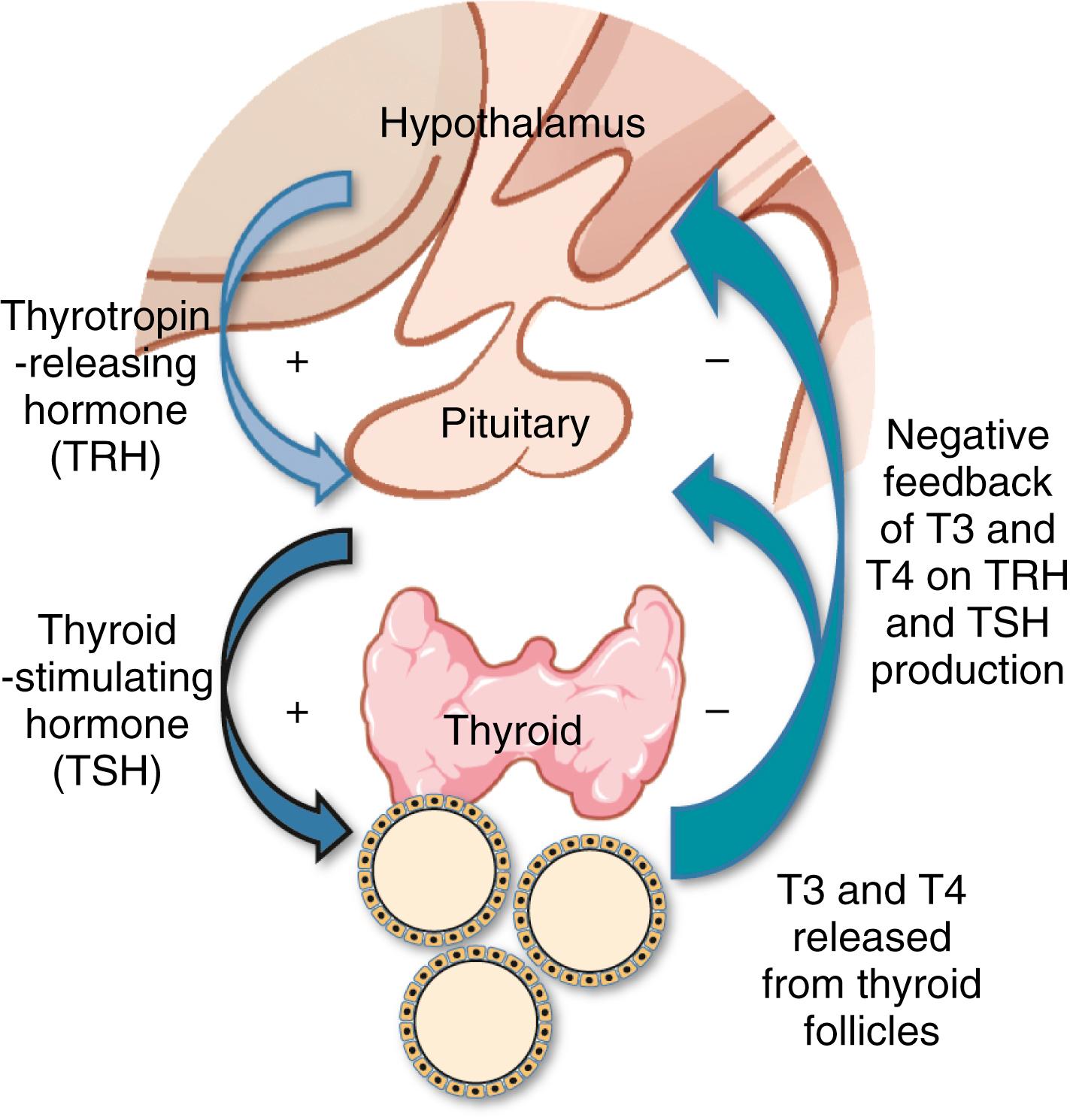
Measurement of T 3 , T 4 and TSH gives a biochemical estimation of thyroid function. TSH is totally suppressed in thyrotoxicosis and elevated in hypothyroidism. Pregnancy or oestrogen administration increases the level of thyroid-binding globulin, so estimation of the ratio of free to bound hormone may be needed. TRH and TSH stimulation tests may be required to determine the site of thyroid hormone production failure.
The thyroid can be imaged by ultrasonography, typically as a first line ( Fig. 21.4 ), or radioisotope scanning ( 99m Tc-sodium pertechnetate behaves like iodine and is ‘trapped’ by the gland). The practice of scanning is to differentiate between ‘hot’ (actively functioning), ‘warm’ (normally functioning) and ‘cold’ (nonfunctioning) thyroid nodules. It is of limited value in differentiating malignant from benign disease. The main value is in evaluating toxic nodular goitres to find out whether it is the nodule that is hyperfunctioning (to be treated by lobectomy) or the internodular tissue that is hyperfunctioning (will need subtotal thyroidectomy).
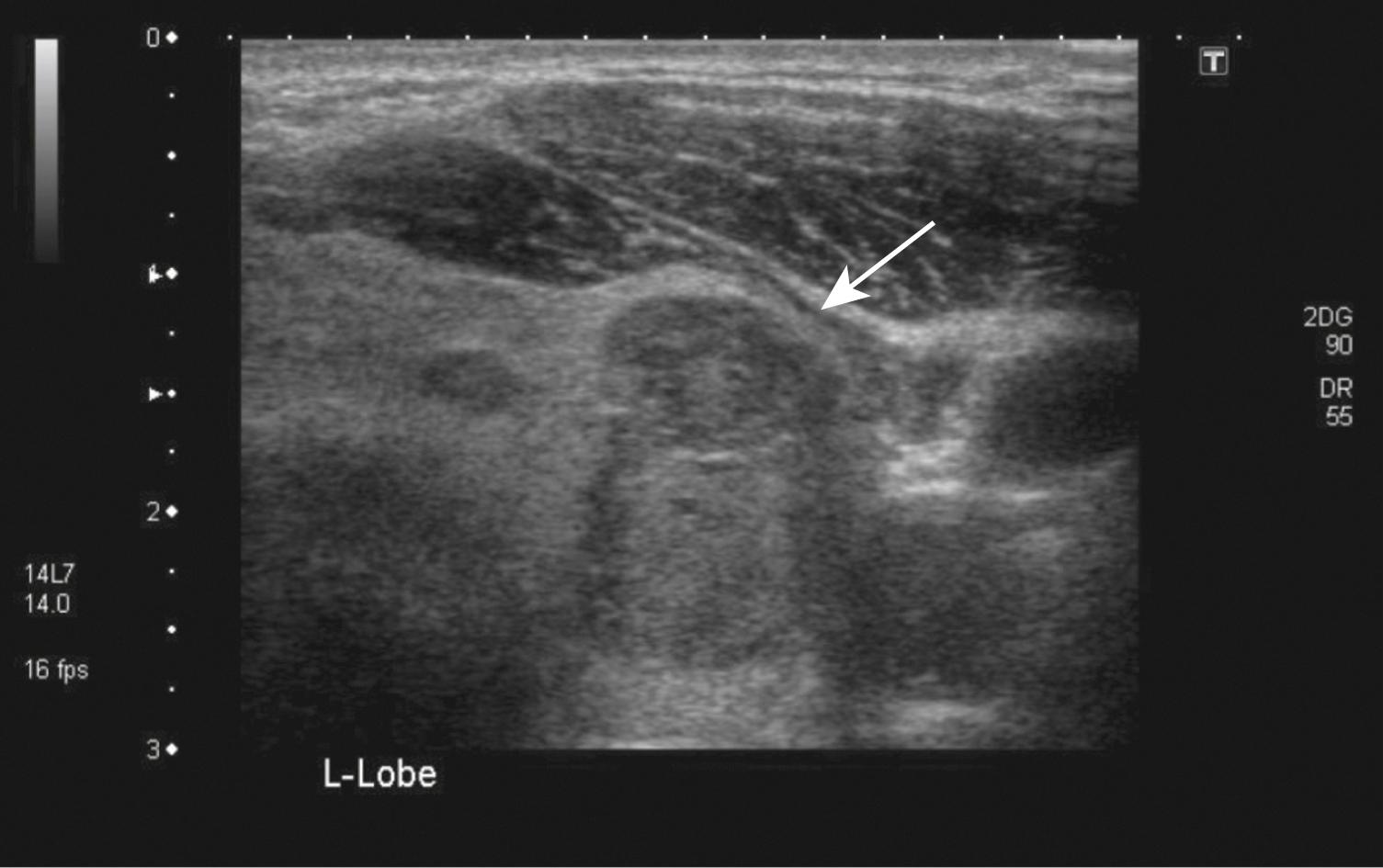
Magnetic resonance imaging (MRI) and computed tomography (CT) provide excellent means of assessing the extent of goitre. Fine-needle aspiration cytology (FNAC) is used to determine the nature of thyroid nodules. Thyroid antibodies detected in any significant titre may indicate autoimmune thyroid disease, such as Graves disease or Hashimoto thyroiditis, and may also be used in cancer surveillance.
Goitre is a visible or palpable enlargement of the thyroid ( Fig. 21.5 ). The swelling appears in the lower part of the neck and retains the shape of the normal gland ( thyreos, Greek for shield). The swelling characteristically moves upwards when swallowing because of the gland’s attachment to the larynx and trachea. Patients may have a dry mouth, and when asking them to swallow, water should be provided.
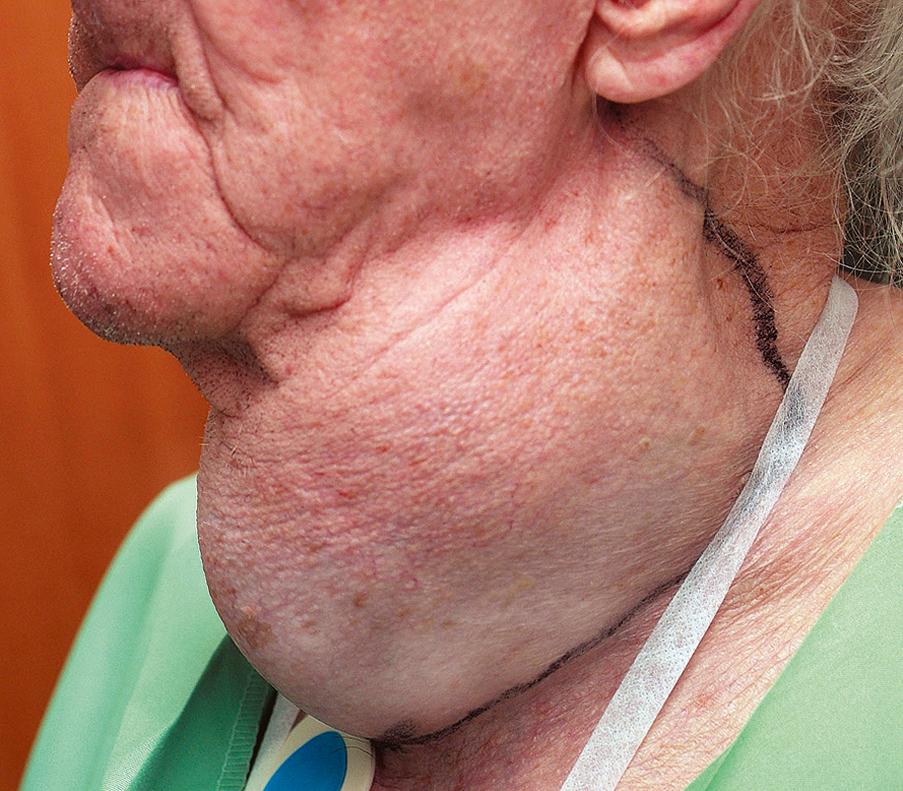
Transient enlargement may occur during puberty or pregnancy.
In the past, lack of iodine in the diet was a common cause of thyroid enlargement, but ‘endemic goitres’ in populations where iodine was deficient are now rare because table salt is iodised. However, nodular goitres still occur in iodine-sufficient populations, and goitrogenous foods (e.g., brassica [cabbage] family), enzymatic defects in thyroid hormonogenesis and background radiation exposure may be responsible. It occurs more commonly in females.
In a degenerative process called ‘nodular hyperplasia’, the gland initially enlarges diffusely as the follicles fill with colloid. Later, multiple nodules develop, some of which contain abundant colloid; others show hyperplastic changes or, more commonly, degenerative changes with the formation of cysts, areas of old and new haemorrhage, and even calcification. The goitre varies greatly in size, from little more than normal to weighing several hundred grams. The whole gland may be involved, or the changes may be confined to one lobe.
Most multinodular goitres are asymptomatic. Others cause tracheal compression, dyspnoea and stridor, particularly when they extend behind the sternum (retrosternal goitre). Oesophageal compression can cause dysphagia. Rarely, bleeding into a nodule may cause pain, rapid enlargement and, for retrosternal goitre, respiratory distress. The thyroid is visibly enlarged, and multiple nodules are usually palpable and mobile over the trachea. Sometimes only one nodule is palpable, giving the erroneous impression of a solitary nodule.
In the case of retrosternal goitre, plain films of the thoracic inlet may reveal tracheal deviation ( Fig. 21.6A ). CT is more sensitive at determining the extent of retrosternal extension together with tracheal compression and the relationship to the great vessels ( Fig. 21.6B ). T 3 , T 4 and TSH are usually normal, in which case, an isotope scan is not indicated.
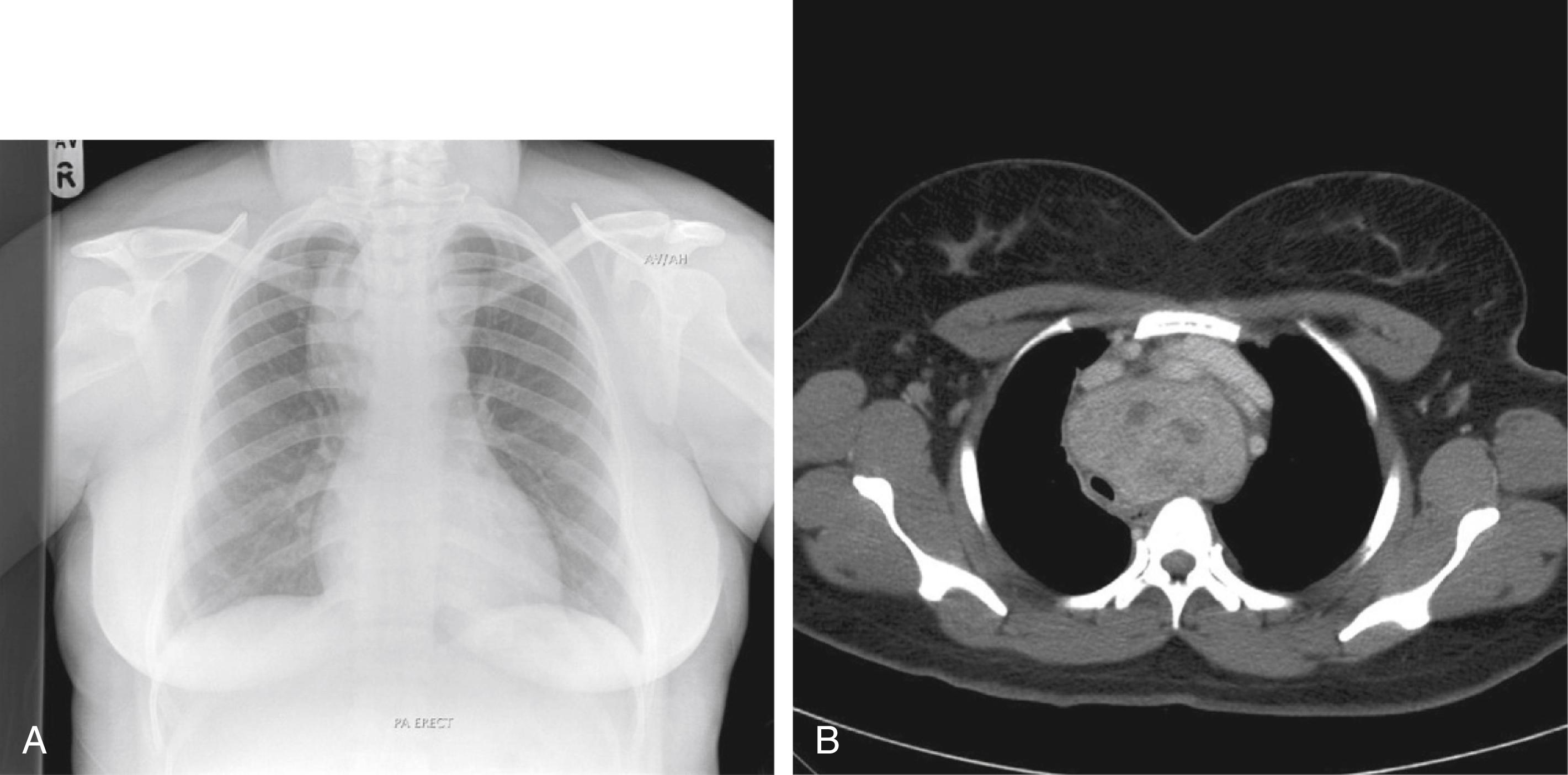
The administration of thyroxine rarely prevents further gland enlargement via the negative-feedback loop. Large goitres and those causing symptoms of compression require total or subtotal thyroidectomy. Some patients request surgery for cosmetic reasons. Patients usually prefer total thyroidectomy with lifelong replacement therapy due to the high chance of recurrence and the need for reoperation with subtotal thyroidectomy.
Diffuse thyroid enlargement can result from stimulation by TSH or TSH-like proteins, resulting in increased production of T 3 and T 4 and thyrotoxicosis.
Physiologic thyroid enlargement may occur during puberty or pregnancy
Nontoxic nodular goitre can be associated with iodine deficiency and drug reactions; it is usually asymptomatic but can cause compression symptoms
Thyrotoxic goitre results from stimulation of the gland by TSH or TSH-like proteins, resulting in excessive production of T 3 and T 4 . About 25% of cases of thyrotoxicosis are due to a toxic multinodular goitre (a long-standing nontoxic goitre develops hyperactive nodule[s] that function independently of TSH levels)
Thyroiditis can produce diffuse painful swelling that may be subacute (de Quervain disease) or autoimmune (Hashimoto disease). Riedel thyroiditis is a very rare cause of painless thyroid swelling and tracheal compression
A solitary thyroid nodule is often a conspicuous palpable nodule in a multinodular goitre. True solitary nodules may be adenomas, cysts or cancers, conditions that are distinguished by FNAC, ultrasonography, isotope scans and function tests
Thyroid cancers can produce a goitre, particularly in the case of medullary carcinoma of the thyroid and lymphoma
This rare condition is associated with an influenza-like illness, during which there is characteristically painful diffuse swelling of the gland. Thyroid antibodies may appear in the serum. The disease may be viral in origin and usually resolves spontaneously. In more severe cases, nonsteroidal antiinflammatory drugs (NSAIDs) or corticosteroids can be administered.
This condition is believed to be due to the destruction of thyroid follicles by lymphocytes. Antibodies against thyroglobulin, thyroid cell cytosol and microsomes are detected in the serum. Histologically, there is marked lymphocytic infiltration around destroyed follicles. It remains the most common cause of hypothyroidism in areas of adequate iodine intake, with a worldwide incidence of 0.3-1.5 cases per 1000 people.
The patient is usually euthyroid, but thyrotoxicosis can occur earlier. In the long term, the patient becomes hypothyroid as the gland is progressively destroyed. Postmenopausal women are most affected (female/male ratio 10:1). The thyroid is diffusely enlarged and firm. A nodular form may be confused with multinodular goitre. Lymphoma may occur in a thyroid that has been affected by long-standing Hashimoto disease.
The diagnosis is made by demonstrating antithyroid antibodies, particularly to microsomal components of the follicle cells. Ultrasound of the thyroid can be useful in determining the nature of any dominant nodules and facilitating a fine-needle aspiration or biopsy for cytology or histology to confirm the diagnosis.
Thyroidectomy is seldom needed and can be difficult because of both the firm nature of the gland and inflammation of the surrounding structures. There is a higher-than-normal risk of damage to the recurrent laryngeal nerves or parathyroid glands. Thyroxine replacement is administered as necessary.
In this very rare condition, the thyroid is replaced by dense fibrous tissue, resulting in a firm painless swelling and tracheal compression. The cause is unknown; surgery is reliably difficult, but decompression of the trachea may be required. Medical management may include corticosteroids, tamoxifen and correction of hypothyroidism if necessary.
Thyroid nodules can be defined as clinically palpable nodules or those found incidentally on radiographic imaging as discrete lesions, distinct from surrounding thyroid tissue. Slow-growing and painless ‘solitary’ nodules are clinically common, although 50% represent a clinically dominant nodule within part of a multinodular goitre. Among patients presenting with a thyroid nodule, the incidence of malignancy is approximately 10%. The others are typically benign adenomas or cysts. All patients with new thyroid nodules should be referred for investigation with the primary aim to identify or exclude malignancy. Patients with concerning features (increasing size, family history of thyroid cancer, previous radiation exposure, patient over 65 years, unexplained hoarseness, cervical lymphadenopathy, stridor) should be urgently referred ( EBM 21.1 ). Ultrasound is a very sensitive examination for thyroid nodules that allows identification of nodules suitable for FNAC ( Fig. 21.7 ). Isotope scans and thyroid function tests aid in the diagnosis. Cysts can be aspirated and, provided they do not refill and cytology is negative for neoplastic cells, they need not be removed. Very rarely, a cyst contains a carcinoma (often papillary) within its wall, and blood-stained aspirate or a residual swelling after aspiration should raise this possibility. A cytopathologist cannot distinguish between a follicular adenoma and follicular carcinoma; this can only be achieved on definitive histopathology by looking for capsular or vascular invasion. Diagnostic surgery is needed if aspiration reveals a follicular neoplasm. Intraoperative frozen section does not always provide a definitive diagnosis, but the demonstration of carcinoma by
‘All patients with new thyroid nodules should be referred for investigation. Patients with concerning features (increasing size, family history of thyroid cancer, previous radiation exposure, patient over 65 years, unexplained hoarseness, cervical lymphadenopathy, stridor) require urgent referral.’ 1
‘USS is the most sensitive first-line investigation in the management of thyroid nodules and is used to determine who needs FNAC. Specific USS signs give rise to a classification system that can be used to differentiate benign from malignant nodules (U1 Normal, U2 Benign, U3 Indeterminate, U4 Suspicious, U5 Malignant).’ 2
‘Results from USS and FNAC, where suspicious for cancer, should be discussed in a specific MDT forum.’ 3
1 NICE Guidance – Improving Outcomes in Head and Neck Cancers http://www.british-thyroid-association.org/Guidelines/
2 http://www.thyroid.org/professionals/ata-professional-guidelines/
3 NICE Guidance – Improving Outcomes in Head and Neck Cancers https://www.nice.org.uk/guidance/csg6/resources/improving-outcomes-in-head-and-neck-cancers-update-773377597
whatever means indicates that more extensive surgery may be needed (e.g., complete total thyroidectomy).
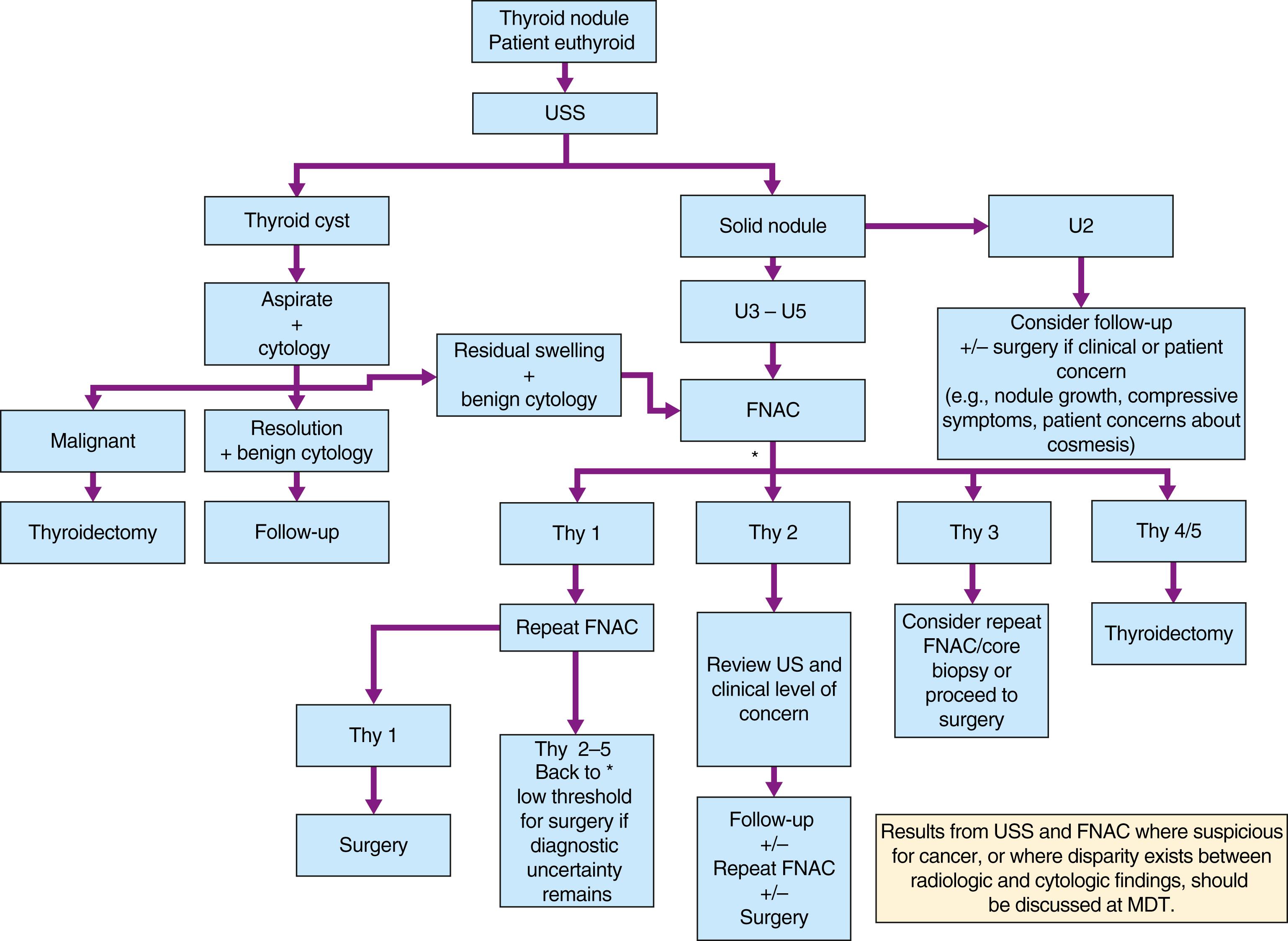
The use of the Bethesda classification allows a standardised category-based reporting system for fine needle aspiration specimens. It consists of six categories and enables assessment of implied cancer risks to guide further management and when surgery is indicated ( Table 21.2 ).
| Diagnostic category | Equivalent Thy classification | Risk of malignancy if noninvasive follicular neoplasm with papillary features (%) | Usual management |
|---|---|---|---|
| I Nondiagnostic or Unsatisfactory |
Thy 1 | 5–10 | Repeat FNA with ultrasound guidance |
| II Benign |
Thy 2 | 0–3 | Clinical and USS follow-up |
| III Atypia of undetermined significance or follicular lesion of undetermined significance |
Thy 3a | 6–18 | Repeat FNA or lobectomy |
| IV Follicular neoplasm or suspicious for a follicular neoplasm |
Thy 3f | 10–40 | Lobectomy |
| V Suspicious for malignancy |
Thy 4 | 45–60 | Thyroidectomy or lobectomy |
| VI Malignant |
Thy 5 | 94–95 | Thyroidectomy or lobectomy |
All forms of thyroid cancer can produce goitre. Lymphoma and anaplastic tumours may cause diffuse thyroid swellings, whereas medullary and follicular tumours are often solitary swellings.
Thyrotoxicosis results from the overproduction of T 3 and T 4 , and serum TSH levels are reduced or undetectable. High circulating levels of T 3 and T 4 increase the basal metabolic rate and potentiate the actions of the sympathetic nervous system. The clinical features of hyperthyroidism are outlined in Table 21.3 . The three conditions that may produce thyrotoxicosis are:
Primary thyrotoxicosis (Graves disease)
Toxic multinodular goitre
Toxic adenoma
| System | Feature |
|---|---|
| Skin | Heat intolerance Skin moist and warm because of peripheral dilatation and excessive sweating |
| Cardiovascular | Cardiac output increased to meet metabolic demands Tachycardia even at rest Arrhythmias and palpitations; atrial fibrillation common |
| Gastrointestinal | Weight loss despite increased appetite Gastrointestinal motility increased |
| Eyes | Upper eyelid retraction and lid lag. The upper eyelids are retracted because the levator palpebrae superioris has some nonstriated muscle innervated by the sympathetic nervous system Exophthalmos common (Graves disease) |
| Other | Fine tremor Hyperkinesia Anxiety and psychiatric disturbance may occur Menstrual irregularity Proximal myopathy Occasionally finger clubbing Pretibial myxoedema (Graves disease) |
This condition accounts for 75% of cases and is an autoimmune disease in which TSH receptors are stimulated by circulating thyroid receptor antibodies (TRAbs). The gland is uniformly hyperactive, very vascular and usually symmetrically enlarged. There is marked epithelial proliferation, with papillary projections into follicles devoid of colloid. TRAbs can cross the placental barrier, so neonatal thyrotoxicosis can occur.
The patient is usually a young female (female/male ratio 8:1), and the condition can be familial. The thyroid is usually moderately and diffusely enlarged and soft, and because of its vascularity, a bruit may be audible.
Some manifestations are more specific to Graves disease and include ophthalmopathy features ( Fig. 21.8 ) and pretibial myxoedema. In Graves ophthalmopathy, inflammation of the extraocular muscles and connective tissue leads to proptosis (exophthalmos) and impaired function of the eye muscles. Pretibial myxoedema commonly presents as raised pigmented lesions on the shins.
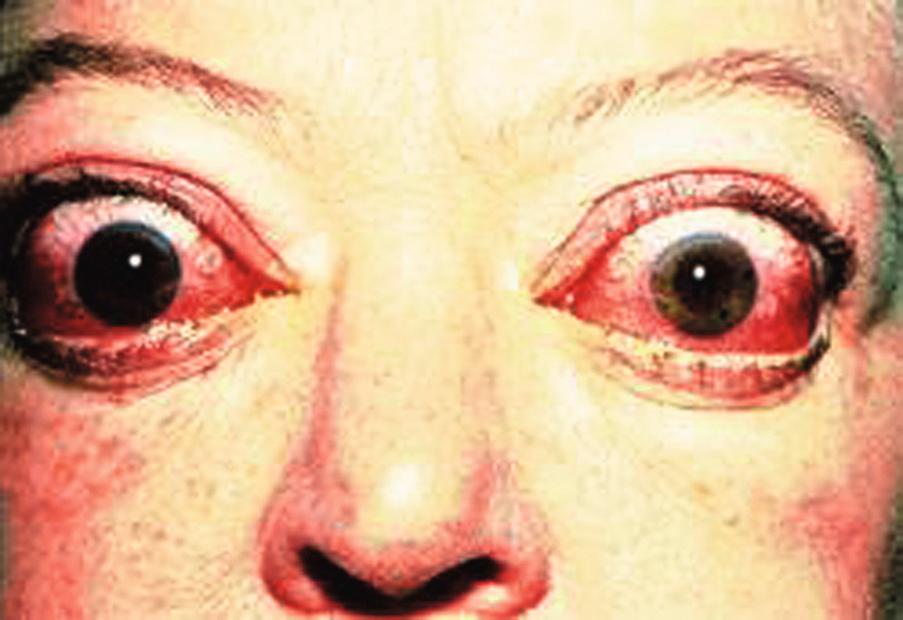
The diagnosis is usually obvious clinically, although in patients with anxiety, distinction from neurosis can be difficult. Raised T 3 and T 4 levels, coupled with low TSH levels, are confirmatory. TSH response to intravenous injection of TRH is absent owing to atrophy of the TSH-producing cells of the pituitary. TSH receptor antibodies (TRAbs) are present in 90% of cases.
These drugs block the incorporation of iodine into tyrosine, preventing the synthesis of T 3 and T 4 . Carbimazole, given in full blocking doses (30–60 mg daily in four divided doses), can render the patient euthyroid within 4 to 6 weeks, but 60% of patients will relapse within 2 years of stopping treatment.
Many consider this to be the treatment of choice. If it is not used in pregnancy, the risks of genetic damage are minimal to both patient and offspring. If ablative doses of iodine are used, patients will require thyroxine replacement but can lead to an otherwise normal life with little risk of recurrence.
Thyroidectomy is a highly successful form of treatment, especially in younger patients. In experienced hands, operative mortality and morbidity are low. Surgery provides a cure with total thyroidectomy being the operation of choice. Subtotal thryoidectomy risks regrowth of the thyroid in up to 50% of patients, with reoperation carrying a much higher risk of complications. Before surgery, patients must be rendered euthyroid with antithyroid drugs. Oral iodine has historically been given for 10 days before surgery to reduce vascularity, but the evidence base to support this is weak. It is thought that iodine causes the thyroid follicles to swell with colloid and compress the interfollicular vessels, in turn decreasing vascularity of the gland. β-Adrenergic blocking drugs are an alternative means of countering the effects of thyrotoxicosis before operation. They block sympathetic overactivity and make the gland less vascular. Cardiac failure, obstructive airways disease and diabetes (which may mask hypoglycaemic symptoms) are contraindications to β-blocker use. Propranolol is given (40–80 mg every 6 hours) with the aim of reducing the pulse rate to below 80 beats per minute. Long-acting preparations may be preferred. The drug is continued on the morning of operation and for 7 days thereafter to avoid ‘thyroid storm’ or ‘thyrotoxic crisis’. Excessive sweating or tachycardia after operation is an indication to increase the dose.
Toxic multinodular goitre is responsible for thyrotoxicosis in around 25% patients. In a long-standing nontoxic goitre, one or more nodules become hyperactive and hyperfunction independently of TSH levels. A single hyperfunctioning adenoma is a rare cause of thyrotoxicosis (1–2% of patients). The adenoma secretes thyroid hormones autonomously; TSH secretion and the remainder of the gland are suppressed.
Toxic multinodular goitre is more common in older women, and cardiac complications such as arrhythmias are particularly frequent due to the presence of an already compromised cardiovascular system. However, eye signs are rare.
In a toxic multinodular goitre, a radioactive iodine isotope scan usually demonstrates multiple ‘patchy’ areas of increased uptake. In toxic adenoma, the nodule is ‘hot’ and the remainder of the gland is ‘cold’.
Treatment consists of removal of the hyperfunctioning glandular tissue by total thyroidectomy (multinodular goitre) or hemithyroidectomy (toxic adenoma), or, if surgery is contraindicated, radioiodine.
Thyroid cancer accounts for around 1% of all forms of malignancy ( Table 21.4 ). Its incidence does appear, however, to be on the increase partly due to increased diagnosis. As with all thyroid disease, females are more often affected (female/male ratio 3:1). The main type of thyroid carcinoma is differentiated thyroid cancer, which is made up of papillary (80%) and follicular (15%) cancers, with the remaining 5% comprised of medullary carcinoma, anaplastic carcinoma, lymphoma and metastatic disease from distant primaries ( EBM 21.2 ). The incidence of thyroid cancer is increased by exposure to ionising radiation, as exemplified by the Chernobyl disaster. Other risk factors include rapid growth of a thyroid lump, family history of thyroid cancer and thyroid cancer syndromes such as multiple endocrine neoplasia (MEN) II, familial adenomatous polyposis and Cowden syndrome. All thyroid cancers should be discussed in a local multidisciplinary team meeting.
| Type | Features | Prognosis |
|---|---|---|
| Papillary (70%) |
|
Excellent 10-year survival: 90% |
| Follicular (20%) |
|
More aggressive than papillary carcinoma 10-year survival: 75% |
| Anaplastic |
|
Very poor prognosis; most patients die within 1 year of diagnosis |
| Medullary |
|
10-year survival: 75% |
| Lymphoma (uncommon) |
|
10-year survival: 40% |
Papillary thyroid cancer (PTC) usually presents as a painless, slow-growing, solitary thyroid swelling typically before the age of 45 years. One-third of individuals present with enlargement of regional (cervical) lymph nodes. In some, cervical lymphadenopathy may be the only clinical finding. The growing prevalence of PTC may be due to an increasing number being incidentally diagnosed (up to 20% of cases) on imaging and operative specimens for benign thyroid disease. Distant metastatic disease is rare.
PTC is an epithelial malignant tumour that typically retains follicular cell differentiation and has unique nuclei features. The presence of Psammoma bodies and chromatin clearing with peripheral margination of chromatin describes the ‘Orphan Annie’ appearance. Nuclear grooves form from the irregularity of enlarged and elongated nuceli crowding and overlapping in two dimensions.
Ultrasound imaging is the modality of choice. It has good sensitivity for detecting lymph nodes and intrathyroid sonographic features of PTC, such as solid nodules with irregular margins, taller in shape than wide, microcalcifications and disorganised internal vascularity. Ultrasound is invaluable in facilitating guided fine-needle aspiration for cytologic analysis.
British Association of Endocrine and Thyroid Surgeons. www.baets.org.uk/Pages/guidelines/.php
National thyroid cancer guidelines group of the British Thyroid Association. www.british-thyroid-association.org
Perros P et al. Guidelines for the Management of Thyroid Cancer. 3rd Edition Clinical Endocrinology Vol 81 Supplement Jul 2014. (BTA, BAETS, ATA)
Due to excellent long-term survival in differentiated thyroid cancer, surgical treatment decisions are more conservative than before. The principle goals are to maximise long-term survival with complete resection and accurate staging whilst also minimising morbidity and avoiding ‘overtreatment’. Recent guidelines advise a risk stratification approach based on preoperative clinical, radiologic and cytologic data ( EBM 21.2 ).
Microscopic disease (≤ 1 cm and unifocal) and ≤ 2 cm tumours with favourable histology and no signs of extrathyroidal disease may be treated with hemithyroidectomy alone. Where there is a family history, previous head and neck radiotherapy or the presence of disease in cervical lymph nodes, total thyroidectomy is indicated. Dissection of lymph nodes is guided by preoperative identification, and they are removed according to anatomic compartments.
Radioiodine therapy is the therapy of choice in patients in PTC to ablate residual thyroid tissue. Widespread metastases are rare but are amenable to radioactive iodine therapy. Radioactive iodine therapy is given 4 to 6 weeks after thyroidectomy. Patients must stop thyroid hormone treatment prior to radioactive iodine therapy to induce a hypothyroid state. Long-term TSH suppression is achieved with levothyroxine therapy to prevent any growth of remaining PTC cells. This is administered to those deemed to be in intermediate to high-risk groups, although TSH suppressive therapy needs consideration due to the risk of long-term reduction in bone density, particularly in young women. PTC has an excellent prognosis, with 10-year survival rates around 90%.
This disease typically presents as a solitary thyroid nodule in patients aged 30 to 50 years. Metastatic spread is mainly haematogenous with deposits in the lungs, bone or liver ( Fig. 21.9 ). Bony secondaries may be pulsatile. Like PTC, follicular thyroid cancer (FTC) is a malignancy of the epithelial follicular cells. Malignant cells are arranged in solid masses with rudimentary acini. Vascular and capsular invasion characterise this neoplasm, distinguishing it from a benign follicular adenoma. It is not possible to differentiate between adenoma and carcinoma preoperatively using FNAC because only aspirated material and cells are seen. Unlike PTC, it does not display diagnostic nuclear features. Diagnosis can only be confirmed histologically in the presence of capsular or vascular invasion. A Hurthle cell variant is composed of predominantly oncocytic or oxyphil cells and is associated with lymph node spread in one in three cases compared to less than one in ten in FTC.
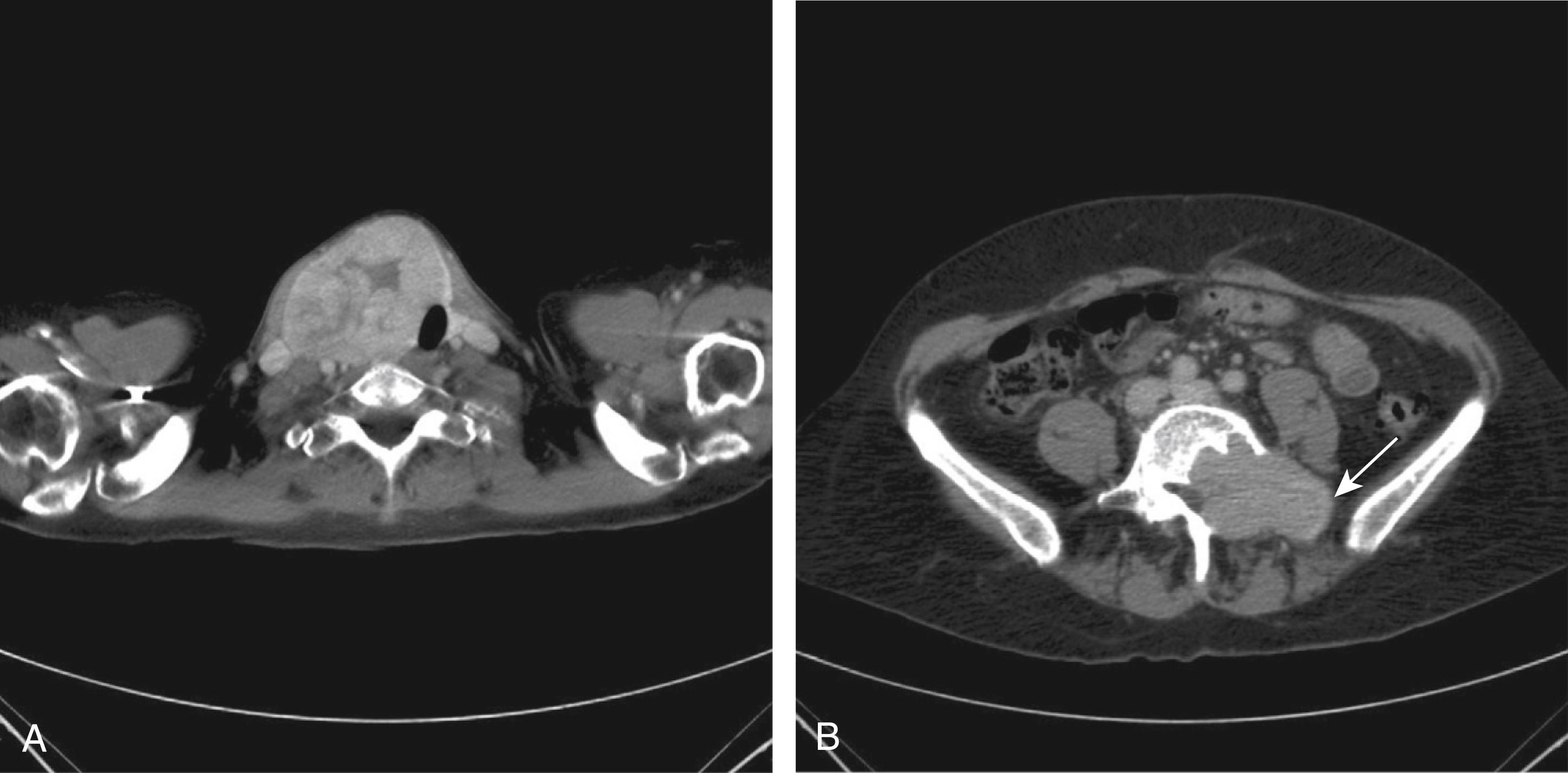
A risk stratification approach is also taken in the management of FTC. If preoperative investigations highlight an invasive tumour or metastatic disease, total thyroidectomy is the procedure of choice. Lymph node dissection is only indicated if there is involvement on preoperative imaging.
Hemithyroidectomy may be sufficient treatment in a patient less than 45 years for FTC that is well-circumscribed, minimally invasive and < 1 cm in size. With diagnostic uncertainty in the Bethesda group 3 and 4, hemithyroidectomy is recommended, but complete thyroidectomy is indicated if subsequent pathology shows evidence of an aggressive tumour, multifocal disease or extrathyroidal extension.
Since the Hurthle cell variant is generally more aggressive and the risk of lymph node involvement greater, intraoperative examination and appropriate removal of central lymph nodes is advised.
Postoperative radioiodine (RAI) therapy is indicated in those with distant metastatic disease, large tumours (> 4 cm) and evidence of extrathyroidal extension. RAI is selectively considered if a combination of clinical factors predict significance risk of recurrence. These include
Primary tumour 1 to 4 cm
Multifocularity > 1 cm
Lymphovascular invasion
Cervical lymph node involvement
Postoperative unstimulated Tg < 5 to 10 ng/mL
Therapeutic decisions require in-depth discussion with the patient, and personalised decision making is advised, weighing individual risk factors within in a multidisciplinary team setting. FTC is more aggressive than PTC and in those aged over 50. The 10-year survival rate is 75%.
Become a Clinical Tree membership for Full access and enjoy Unlimited articles
If you are a member. Log in here